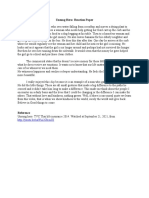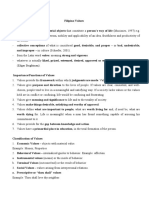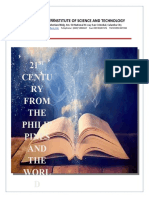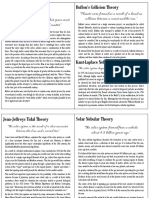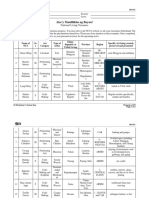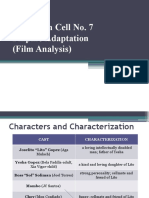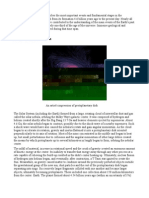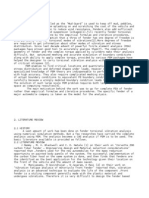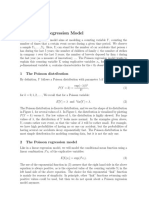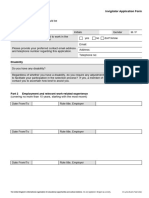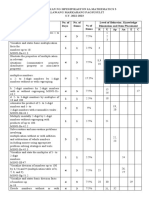Reaction Paper
Reaction Paper
Uploaded by
Marjorie Buenaventura SibulCopyright:
Available Formats
Reaction Paper
Reaction Paper
Uploaded by
Marjorie Buenaventura SibulOriginal Description:
Copyright
Available Formats
Share this document
Did you find this document useful?
Is this content inappropriate?
Copyright:
Available Formats
Reaction Paper
Reaction Paper
Uploaded by
Marjorie Buenaventura SibulCopyright:
Available Formats
Marjorie B.
Sibul G12-STEM A
" History of the Earth"
According to the video, the history of Earth covers approximately 4 billion years from Earth’s
formation out of the solar nebula to the present. Earth formed as part of the birth of the solar
system which initially existed as a large, rotating cloud of dust and gas. It was composed of
hydrogen and helium produced in the Big Bang, as well as heavier elements produced by stars
long gone. Then, about 4.6 billion years ago, a nearby star probably became a supernova. The
explosion sent a shock wave toward the solar nebula and caused it to contract. As the cloud
continued to rotate, gravity and inertia flattened the cloud into a proto- planetary disc,
perpendicular to its axis of rotation. Most of the mass concentrated in the middle and began to
heat up. The impossibility of kinetic heat, produced by the infall of matter escaping caused the
centre to heat up sufficiently to enable the centre of the concentration to produce its own
internal heat source through nuclear fusion of hydrogen into helium, starting as a T Tauri star,
our early sun. Meanwhile, as gravity caused matter to condense around dust particles, the rest
of the disc started to break up into rings. Small fragments collided and became larger
fragments. These included one collection approximately 150 million kilometers from the centre:
Earth. As the Sun condensed and heated, fusion began, and the resulting T Tauri solar wind
cleared out most of the material in the disc that had not already condensed into larger
bodies.The origin of the Moon is still uncertain, although much evidence exists for the giant
impact hypothesis. Earth may not have been the only planet forming 150 million kilometers
from the Sun. It is hypothesized that another collection occurred 150 million kilometers from
both the Sun and the Earth, at the fourth or fifth Lagrangian point. This planet, named Theia, is
thought to have been smaller than the current Earth, probably about the size and mass of Mars.
Its orbit may at first have been stable but destabilized as Earth increased its mass by the
accretion of more and more material. Theia swung back and forth relative to Earth until, finally,
an estimated 4.533 billion years ago (perhaps 12:05 a.m. on our clock), it collided at a low,
oblique angle. The low speed and angle were not enough to destroy Earth, but a large portion
of its crust was ejected. Heavier elements from Theia sank to Earth’s core, while the remaining
material and ejecta condensed into a single body within a couple of weeks. Under the influence
of its own gravity, this became a more spherical body: the Moon. The impact is also thought to
have changed Earth’s axis to produce the large 23.5° axial tilt that is responsible for Earth’s
seasons. (A simple, ideal model of the planets’ origins would have axial tilts of 0° with no
recognizable seasons.) It may also have speed up Earth’s rotation and initiated the planet’s plate
tectonics
You might also like
- Philippine Festivals Are IMPORTANTDocument1 pagePhilippine Festivals Are IMPORTANTRaymond FabiculananNo ratings yet
- Wika BrochureDocument2 pagesWika BrochureAngela Santillan Patenio100% (1)
- Martial Law Concept PaperDocument5 pagesMartial Law Concept PaperJoshua RoqueNo ratings yet
- Story of Charice PempengcoDocument2 pagesStory of Charice PempengcoRENGIE GALONo ratings yet
- Unsung Hero: Reaction PaperDocument3 pagesUnsung Hero: Reaction PaperKaira Alessandra TanNo ratings yet
- SocsciDocument6 pagesSocsciNieva Marie EstenzoNo ratings yet
- Reaction Paper Jurassic ParkDocument2 pagesReaction Paper Jurassic Parkjon_palmares67% (6)
- Learning Activity #2 Heritage Mapping Community: Sarrat, Ilocos Norte Place With Cultural Significance Cultural Significance Impact To The SelfDocument4 pagesLearning Activity #2 Heritage Mapping Community: Sarrat, Ilocos Norte Place With Cultural Significance Cultural Significance Impact To The SelfRomeoNo ratings yet
- MODULE WEEK 1 Vision, Mission and Core ValuesDocument3 pagesMODULE WEEK 1 Vision, Mission and Core ValuesK wongNo ratings yet
- UCSP ScriptDocument6 pagesUCSP ScriptAnn Madrigal MauzarNo ratings yet
- 1 The Order of The National Artists AwardDocument4 pages1 The Order of The National Artists AwardEderle CombisNo ratings yet
- Scientist of Soil SciencesDocument7 pagesScientist of Soil SciencesedlordviadanNo ratings yet
- 5 Filipino ValuesDocument4 pages5 Filipino ValuesCassie Mae MallariNo ratings yet
- Historical Development in Accounting ThoughtsDocument1 pageHistorical Development in Accounting ThoughtsantibacterialsoapNo ratings yet
- Teofilo GarciaDocument9 pagesTeofilo GarciaandreNo ratings yet
- Unit 2 Classification of Various Art Forms in The PhilippinesDocument13 pagesUnit 2 Classification of Various Art Forms in The PhilippinesSushi The NinthNo ratings yet
- Climate Change: Position PaperDocument2 pagesClimate Change: Position PaperAngela Jontilano100% (1)
- My Personal Timeline: Jas ADocument1 pageMy Personal Timeline: Jas AFranz Danah AtiwagNo ratings yet
- Prepared By: Ferdinand Ariel Jaylo (Bsar-1A)Document1 pagePrepared By: Ferdinand Ariel Jaylo (Bsar-1A)Ferdinand Ariel JayloNo ratings yet
- Com Arts Sssssssss Do NNNN EeeDocument5 pagesCom Arts Sssssssss Do NNNN EeeRaven Zeijiku50% (2)
- Ucsp-Grade 11Document2 pagesUcsp-Grade 11Reina Alliyah GonzalesNo ratings yet
- Lesson 9 The Outstanding FilipinoDocument3 pagesLesson 9 The Outstanding FilipinoJohanna Rachel S. VillasisNo ratings yet
- The Compartmentalized Life MatrixDocument2 pagesThe Compartmentalized Life Matrixivan chuaNo ratings yet
- Discuss The Tragic Experiences of The Filipinos in The Hands of The Spaniards As Mentioned in The DocumentDocument2 pagesDiscuss The Tragic Experiences of The Filipinos in The Hands of The Spaniards As Mentioned in The DocumentMarian Grace BalladaresNo ratings yet
- Fernando Amorsolo: Awards and AchievementsDocument1 pageFernando Amorsolo: Awards and AchievementsKIMNo ratings yet
- 2ND Week in Socsci 101Document16 pages2ND Week in Socsci 101Marlon AndayaNo ratings yet
- Defense QuestionsDocument2 pagesDefense QuestionsMel PangalNo ratings yet
- Municipality of AlilemDocument5 pagesMunicipality of AlilemJoanna Marie ForgesNo ratings yet
- Levi CelerioDocument7 pagesLevi CelerioK SNo ratings yet
- Theories Regarding The Origin of The Solar SystemDocument3 pagesTheories Regarding The Origin of The Solar SystemGiorjia Mae Veran100% (1)
- Leonor Orosa GoquingcoDocument12 pagesLeonor Orosa GoquingcoJoe Carr100% (1)
- Ako'y Manlilikha NG Bayan!: National Living TreasuresDocument2 pagesAko'y Manlilikha NG Bayan!: National Living TreasuresLime LontocNo ratings yet
- Miracle in Cell No. 7 Filipino Adaptation (Film Analysis)Document7 pagesMiracle in Cell No. 7 Filipino Adaptation (Film Analysis)ella bonostroNo ratings yet
- Man As A SubjectDocument21 pagesMan As A SubjectMin MinNo ratings yet
- Philippine ArtistDocument6 pagesPhilippine ArtistJulie AnnNo ratings yet
- Dekada 70Document3 pagesDekada 70Bryent GawNo ratings yet
- 4.1 Advocacy Video ScriptDocument2 pages4.1 Advocacy Video ScriptPreetiz Bernal Angulo50% (2)
- Chapter-1-Practical-Research TattoosDocument9 pagesChapter-1-Practical-Research TattoosJocelyn RosalNo ratings yet
- KALKALDocument1 pageKALKALJames Vincent CiruelosNo ratings yet
- Levi CelerioDocument26 pagesLevi CelerioJames Lopez100% (1)
- Review of Related LiteratureDocument32 pagesReview of Related LiteratureMiguel Hernandez0% (1)
- Gregorio Forgive Us AllDocument4 pagesGregorio Forgive Us Allluhhh celllNo ratings yet
- Movie Review-The CoreDocument2 pagesMovie Review-The CoreMicaela Kaye Margullo Monterey100% (1)
- MIL Module2OutputDocument2 pagesMIL Module2OutputMaximo CajerasNo ratings yet
- BALANAKONDocument3 pagesBALANAKONMonina Cahilig100% (1)
- Iskolar NG BayanDocument1 pageIskolar NG BayanmengkymagubatNo ratings yet
- Understanding The Self Lesson 4Document9 pagesUnderstanding The Self Lesson 4Kherwin ValenciaNo ratings yet
- Position Paper About HazingDocument1 pagePosition Paper About HazingFaith Niña Fernandez JauodNo ratings yet
- Industrial Era (1440-1890)Document25 pagesIndustrial Era (1440-1890)Louise Ramos0% (1)
- 21ST Technology Based Art ReviewerDocument2 pages21ST Technology Based Art ReviewerFarrah MacalinoNo ratings yet
- CHAPTER 3 (Research Paper)Document4 pagesCHAPTER 3 (Research Paper)Kyle Jazmine SegalesNo ratings yet
- Can We Get Rid of Filipino TimeDocument3 pagesCan We Get Rid of Filipino TimeZoey AdorNo ratings yet
- Research 7Document22 pagesResearch 7Kyle CamayangNo ratings yet
- Dinagyang FestivalDocument21 pagesDinagyang FestivalJunior Buenaventura100% (1)
- History of Universidad de Sta Isabel: ONE USI Vision - MissionDocument8 pagesHistory of Universidad de Sta Isabel: ONE USI Vision - MissionMark Christian RamosNo ratings yet
- Theater 1. Honorata "Atang" Dela RamaDocument2 pagesTheater 1. Honorata "Atang" Dela RamaeyecandyNo ratings yet
- History of Notre Dame of ParangDocument2 pagesHistory of Notre Dame of ParangGlenda Ortillano LeeNo ratings yet
- Saw Aw ADocument19 pagesSaw Aw AAditya Kumar SinghNo ratings yet
- John Vincent CarismaDocument3 pagesJohn Vincent CarismaVincent CarismaNo ratings yet
- EarthDocument179 pagesEarthaproditi50% (2)
- LAB 4 IzodDocument3 pagesLAB 4 IzodFatin NabihaNo ratings yet
- INTRODUCTION The Fender' Called As The Mud-Guard' Is UsedDocument13 pagesINTRODUCTION The Fender' Called As The Mud-Guard' Is Usedanon-458085No ratings yet
- The Poisson Regression ModelDocument6 pagesThe Poisson Regression ModelmaxNo ratings yet
- Remembering 10% Understanding 12% Applying 16% Analyzing 18% Evaluating 20% Creating 24%Document1 pageRemembering 10% Understanding 12% Applying 16% Analyzing 18% Evaluating 20% Creating 24%Rowen Jay Loquillano100% (1)
- EP101 revisedfinalwithanswers21JunJASDocument10 pagesEP101 revisedfinalwithanswers21JunJASAngellaNo ratings yet
- JP002 Tin Whiskers TheoryDocument30 pagesJP002 Tin Whiskers Theorydemolinux100% (3)
- Invigilator Application Form 5Document4 pagesInvigilator Application Form 5Isini sehansa amarathungaNo ratings yet
- Lesson 1-4 - Materials, Tools, Equipment and Testing DevicesDocument21 pagesLesson 1-4 - Materials, Tools, Equipment and Testing Devicesanthony t. aviles100% (5)
- Remarkable EngineersDocument220 pagesRemarkable EngineersOsmaChaos100% (2)
- MathDocument2 pagesMathivy guevarraNo ratings yet
- Math 3Document4 pagesMath 3VANESSA MAE NAVERANo ratings yet
- Science Club Action Plan 22-23Document3 pagesScience Club Action Plan 22-23Marlene Tubieros - InducilNo ratings yet
- Lesson 3-Enrichment ActivitiesDocument4 pagesLesson 3-Enrichment ActivitiesFrance Lee ManobanNo ratings yet
- 001A - API - U - 6A Brochure - QatarDocument3 pages001A - API - U - 6A Brochure - QatarcoxshulerNo ratings yet
- Eapp. Quarter 1 Module 1 and Q1 Module 2 Addtional Activities.Document3 pagesEapp. Quarter 1 Module 1 and Q1 Module 2 Addtional Activities.keith tambaNo ratings yet
- Bulletin: I T W PDocument40 pagesBulletin: I T W PWally ConleyNo ratings yet
- Book of Abstracts 5th ARC 2 PDFDocument112 pagesBook of Abstracts 5th ARC 2 PDFErin Walker100% (1)
- Advanced Certificate in Management of Leak Detection On Water MainsDocument2 pagesAdvanced Certificate in Management of Leak Detection On Water Mainsyuki michaelNo ratings yet
- US State Dept - Congressional Budget Justification Foreign Operations Appendix 2 - Fiscal Year 2017Document717 pagesUS State Dept - Congressional Budget Justification Foreign Operations Appendix 2 - Fiscal Year 2017Seni NabouNo ratings yet
- Energy Forms and Changes 4Document4 pagesEnergy Forms and Changes 4api-358170996No ratings yet
- Communicative SkillsDocument196 pagesCommunicative SkillsAnastasiaNo ratings yet
- Doing Philo 2Document48 pagesDoing Philo 2Michael Ricalde BustosNo ratings yet
- Ielts WritingDocument19 pagesIelts WritingAbderrahim ZineNo ratings yet
- Name: Teacher: Date: Score:: Identifying Functions From GraphsDocument2 pagesName: Teacher: Date: Score:: Identifying Functions From GraphsAnabbNo ratings yet
- Meta-Analysis On The Effect of Zinc On Reducing Diarrhea Episode in ToddlersDocument9 pagesMeta-Analysis On The Effect of Zinc On Reducing Diarrhea Episode in ToddlersWilly Rizal BriyantoNo ratings yet
- Cognitive DevelopmentDocument30 pagesCognitive DevelopmentjeromeNo ratings yet
- The Programming: Million Dollar PrizeDocument6 pagesThe Programming: Million Dollar Prize梅止观No ratings yet
- ASEANCCTHandbook V2 PDFDocument253 pagesASEANCCTHandbook V2 PDFYin ThoNo ratings yet
- Daily Lesson Plan Ts25 SMK Seri Bintang UtaraDocument2 pagesDaily Lesson Plan Ts25 SMK Seri Bintang UtaraNURUL FATIN BINTI AZLIM / UPMNo ratings yet
- Motivational Approach (Ed 234)Document13 pagesMotivational Approach (Ed 234)Omairah bantasanNo ratings yet




